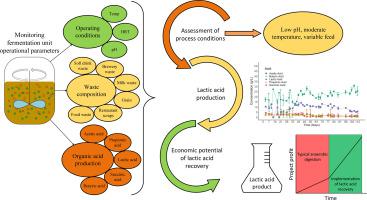Journal of Cleaner Production ( IF 9.7 ) Pub Date : 2020-11-24 , DOI: 10.1016/j.jclepro.2020.125243 Christopher H. Bühlmann , Bede S. Mickan , Stephan Tait , Michael Renton , Parisa A. Bahri

|
Anaerobic digestion facilities can become biorefineries to produce higher-value products together with biogas energy and nutrient-rich digestate. To inform future biorefinery concepts with lactic acid recovery, the current study monitored organic acids in a pre-fermentation stage at a commercial anaerobic digestion facility. The study assessed lactic acid production performance and impact of mixed food waste feedstocks and process conditions. Feed rate and feedstock composition varied weekly with waste availability. Normal operating conditions of the pre-fermentation stage included warm ambient conditions (24-35 °C), low pH (3.45±0.03), a short hydraulic retention time (1-3.5 days) and stable organic loading rate (12±2 kgVS.m-3.day-1). These conditions favoured lactic acid, being dominant at an encouraging average concentration of 21.70 g L-1, notably without any process optimisation or control. Lactobacillus constituted the majority of the microbial community in the pre-fermentation stage (98.1 % – 99.1 % relative abundance) with an unknown Lactobacillus species and L. reuteri being the major species present. Grain processing waste and milk paste were positive influencers of LA concentration. The monitoring results, together with a simple economic evaluation, indicated that lactic acid recovery from a commercial food waste anaerobic digestion facility had baseline feasibility. In addition, there would be significant opportunities to increase economic performance by targeted process control and optimisation.
中文翻译:

商业沼气设施中来自混合食物垃圾的乳酸:原料和工艺条件的影响
厌氧消化设施可以成为生物精炼厂,以与沼气能源和营养丰富的消化物一起生产更高价值的产品。为了使未来的生物精炼概念具有乳酸回收功能,当前的研究在商业厌氧消化设施的发酵前阶段监测了有机酸。该研究评估了乳酸的生产性能以及混合食物垃圾原料和工艺条件的影响。每周的进料速度和原料组成随废物利用率而变化。发酵前阶段的正常操作条件包括温暖的环境条件(24-35°C),低pH(3.45±0.03),较短的水力停留时间(1-3.5天)和稳定的有机负荷率(12±2 kgVS) .m -3 .day -1)。这些条件有利于乳酸,其在令人鼓舞的平均浓度为21.70 g L -1时占优势,尤其是在没有任何工艺优化或控制的情况下。乳酸菌构成了发酵前阶段微生物群落的大部分(相对丰度为98.1%– 99.1%),其中未知的乳酸菌物种和罗伊氏乳杆菌是目前的主要物种。谷物加工废料和牛奶糊是LA浓度的积极影响因素。监测结果以及简单的经济评估表明,从商业食品垃圾厌氧消化设施中回收乳酸具有基线可行性。此外,通过有针对性的过程控制和优化,将有大量机会提高经济绩效。











































 京公网安备 11010802027423号
京公网安备 11010802027423号